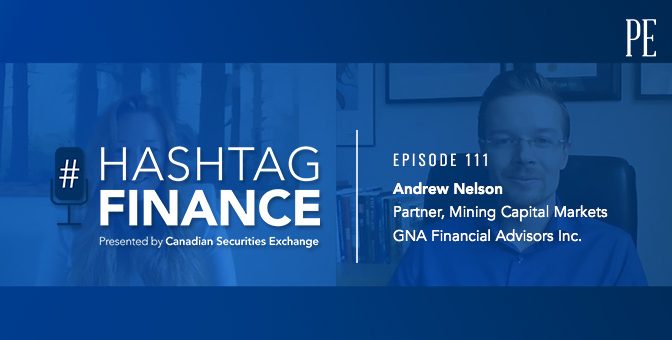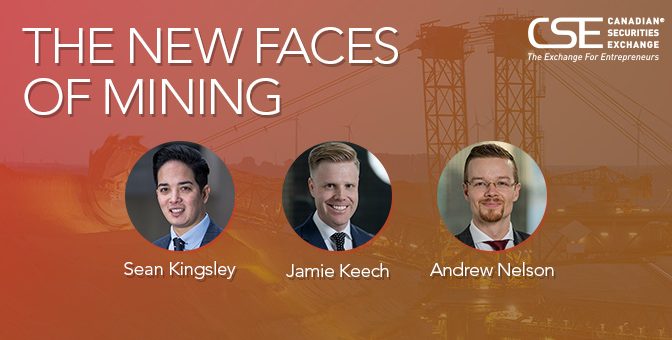Participants:
Andrew Nelson, CPA, Mining Investment Analyst, Dundee Goodman Merchant Partners
Jamie Keech, Founder & CEO, Ivaldi Venture Capital
Sean Kingsley, Vice President, Corporate Development, Cabral Gold
They’re young. They’re powerful. And that wave of power is growing – quickly.
Meet the millennial investor. Now, the catch: getting them interested in investing in the mining and metals industry. It’s a relatively untapped investor demographic, on the back of a tough half-decade in the space.
But the potential for opportunity is growing, and this group of investors is demanding more of the industry: from more connectivity to increased transparency (and beyond).
Public Entrepreneur spoke to three up-and-coming millennials who are helping push the space forward.
To register for an exclusive CSE Talks session at PDAC 2019 featuring the new faces of mining, click here: https://www.eventbrite.ca/e/cse-talks-new-faces-of-mining-tickets-57041685216
Tell me a bit about your background. How did you get involved in the mining industry?
AN: I began my professional career as a financial auditor while simultaneously completing the Chartered Professional Accountant designation. Later, I transitioned to investment banking, joining Dundee Securities, which recently became Dundee Goodman Merchant Partners, a mining-focused merchant bank. The clientele and deals I’ve been involved with have always exclusively been mining.
JK: I’m a mining engineer. I’ve worked in a variety of places: Albania, Hong Kong, Mongolia, Baffin Island and have had a lot of different jobs on the technical side. In Vancouver, I worked primarily with a small management team that built a company that is called Equinox Gold. I left about a year ago to start my own venture: it’s called Ivaldi Venture Capital. We also run an investment research service called Resource Insider. We’re focused on deploying capital into mining and metals projects. We’ve done several deals over the last year, ranging between $1 million to $3 million.
SK: My family has lived in Vancouver for over 125 years – we are one of the oldest Chinese families here so being a part of a legacy has always driven my interests into building something long-lasting. There’s nothing more constant than the need for minerals in the world. I’ve been hooked in the industry for over 12 years and plan to be for as long as I live. I currently do corporate communications and development for two Brazilian-focused junior companies.
We’ve moved from a landscape dominated by resource exploration/development companies to one that now includes a major cannabis presence and increasing prominence of tech stories. How do you look at this new environment and what appear to be the challenges?
JK: When it comes to mining, younger investors haven’t really had the chance to come into the space. I’m a millennial and during the last bull market, I was 24. I didn’t have any money to spend and most 24-year-olds are in that same situation. There hasn’t been much interest in mining since that time because there hasn’t been much opportunity to be interested. That money has gone to the cannabis space, the crypto space: these are industries that millennials are able to relate to very easily because people smoke cannabis and people grew up on the Internet.
AN: What’s going to get millennials interested in mining is a broad commodity bull market in the resource space. Most millennials aren’t familiar with the wealth creation the resource space can offer and have recently been attracted to high flying sectors such as cannabis, cryptocurrency, and blockchain, until the financial hangover set in.
A recent resource example were the parabolic moves in lithium and cobalt which was due to the electric vehicle trend. This was very engaging for millennials who can understand Tesla and lithium-ion batteries in their cellphones. Many of my friends who are not resource professionals would be talking about these commodities as a reaction to the rising share prices and they wanted a piece of the action.
SK: Alternative companies and sectors outside of mining have done well to get their stories and opportunities out to a new wave of investors, millennials. Ten years ago, you wouldn’t see my generation investing in stocks yet now they all have brokerage accounts.
It’s now up to us as an industry to capture their attention through avenues that they could relate to and not just the stories of how the industry titans like mining billionaires Robert Friedland and Ross Beatty got their investors and themselves very rich. We need to teach millennials that mining is the most constant sector and has tremendous upside and applications through avenues such as video, virtual reality, social campaigns, and telling stories that would resonate and engage their curiosity and understanding of the resource sector. It is time for our industry to innovate, rejuvenate and disrupt how it once was.
Gold and silver have long been a primary focus for investors in the mining space but new market segments, such as battery metals, have the potential to attract a different type of investor. What do you think about this?
JK: I think it’s happened. The energy metals sector, be it lithium, cobalt, vanadium, has done a very admirable job of piggybacking on the tech industry. Elon Musk has inadvertently become one of the most successful mining promoters in history. There’s been a demand and companies have done an impressive job of tying their product into something people care about, as compared to mining.
SK: There is money to be made in these new segments. I’ll take us back to 2006-2008 when the craze in the sector was rare earth metals. Unfortunately, China came in and flooded the market with supply and that quickly stopped the demand, but the run-up saw investors making money. Come 2011, it was all about graphite and graphene. Again, the market got flooded but investors made money. Here we are, now comes energy metals: cobalt, lithium, vanadium. Yes, these battery metals are desperately needed as we revolutionize the way we live and do things and investors will make money, but these run-ups are not constant like precious metals gold and silver.
AN: From a market observation, most battery metals such as lithium and cobalt are very small markets, each approximately sub-US$10 billion relative to gold and copper, which are around US$100 billion-plus. It doesn’t take much capital to move these smaller markets and those are trades that you need to get in and get out of within a 12 to 24 month timeframe. A lot of those companies are speculation, rather than investments. The point is, if you want to speculate in these small markets, make sure you have impeccable timing.
What is the entry point to getting a millennial investor to begin researching a mining stock? How do you get them interested in the first place and what feedback have you had from this generation of investors?
JK: I think about this a lot. In other industries there are influencers. It’s not a coincidence that Kylie Jenner’s makeup company is a billion-dollar company. It has nothing to do with the quality of the product, it has to do with her persona. There are not a lot of young influencers within the mining industry. There are a few people my age (30s) and there are a lot of people in their 60s.
There’s a gap and I think we need more public-facing influencers – letter writers, CEOs, leaders in the industry of any type that can generate interest – and that will bring them into the industry. That said, influencers have to get the timing right. If there’s not money to be made, no one is going to care.
When I think about mining, there’s an adventure aspect to it: there’s travel to exotic locations and we know millennials are the best-travelled generation yet. This is an aspect that can engage people and enable them to see the potential in the space. That’s what’s going to bring investors in. It’s a multi-step process. You need an interesting story, you need the potential to make money, and you need public facing personas that people trust.
SK: For me, it’s got to be about the tremendous upside in value creation and I often point to the discovery phase of the Lassonde Curve chart which outlines the life of mining companies beginning at exploration and ending in production, showing value that the market attributes to each stage.
Once millennials really start to understand that everything in the world is only possible with the minerals that we discover and mine and of what opportunities that creates for our generation will they realize the endless possibilities and upside potential of the sector.
AN: There’s a massive opportunity here to shift the way millennials look at investing in mining. Millennials are now the largest generation in Canada, but are the least invested in stocks, but are the most likely to participate in an online financing. Recently, I received a shell opportunity in my inbox. I passed but another millennial I know subscribed. To partake only required 5 minutes and was a very simple process. The company raised 324% over their targeted funding and brought in 201 investors in a matter of six days. This is one of the major platforms I believe will be used to complete resource financings with millennial investors.
To register for an exclusive CSE Talks session at PDAC 2019 featuring the new faces of mining, click here: https://www.eventbrite.ca/e/cse-talks-new-faces-of-mining-tickets-57041685216


